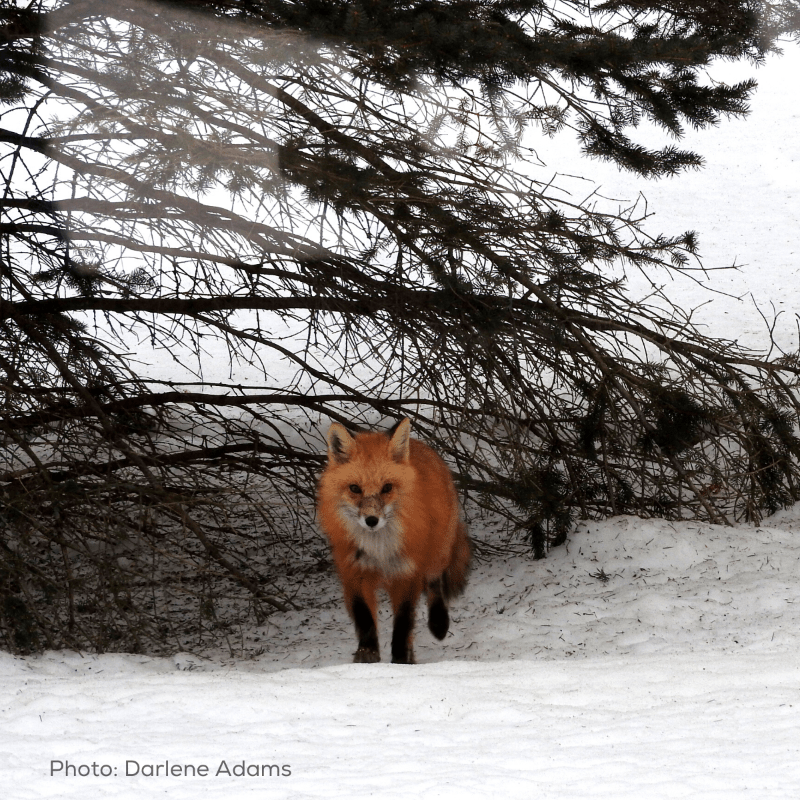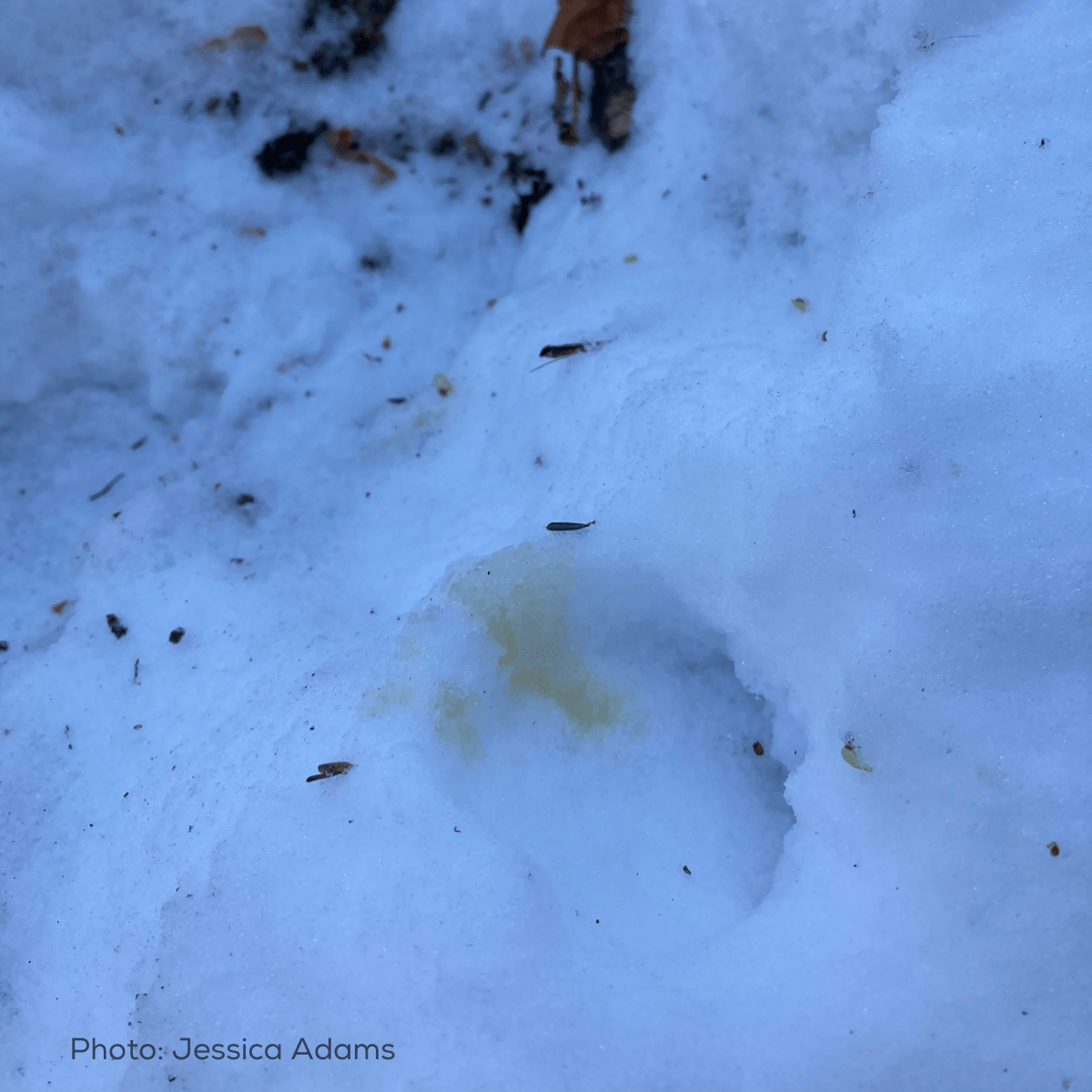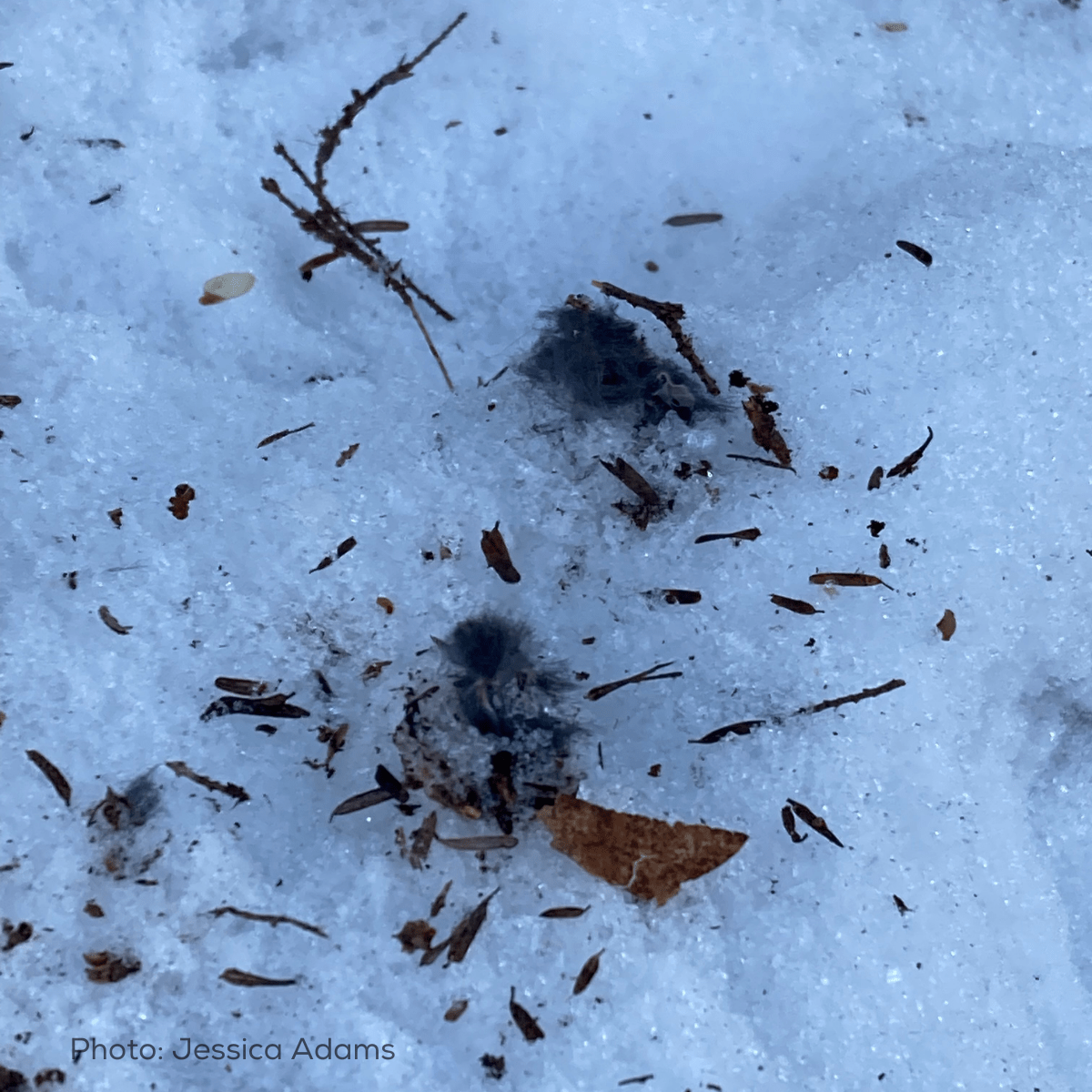
Written by Jessica Adams (Nature Nerding)
Reading Time : 5-7 minutes
Two of my most memorable Nature Nerding experiences happened in the Massawippi Foundation’s trails last winter and both came about because I followed my nose…
While hiking back up from the lake at the Massawippi Trail in Sainte-Catherine-de-Hatley last February, I paused abruptly because I caught a hint of something pungent in the fresh winter air. Being quite certain what it was made me keen to have a poke around the trail. My friend watched as I let my nose be my guide, finally stumbling upon the source of the odour.
“Fox pee!” I exclaimed. My unbridled enthusiasm piqued hers and so I went on. “See? If you crouch down just here and sniff, you’ll smell a ‘skunky’ smell.”
Because she knows me and loves me just as I am, she obliged and a bemused, yet intrigued look came across her face. The investigation ensued. We followed the tracks leading to and from the urine and came across yet another goldmine of discovery: a mini kill site. Some small mammal had met its maker at the hand (paw) of a hungry Red Fox. And we got to see the disturbed snow and a few tufts of fur. Not so cool for the little critter, but a very neat find for a keener like me.
Fast forward to March 2022 and we are leading one of our first school activities at Scowen Park when that familiar smell wafts my way. With approximately 20 elementary school students in tow this time, the process of stopping is somewhat trickier. The look of excitement on my face manages to get everyone’s attention, however, and so I proceed to share my observation. And while talking about what my nose is picking up, I scan the surrounding area for tracks and traces. There it was, as though I had planned it. Right next to the trail is a spot of fox urine on a snow-covered log.

The kiddos who were curious enough, got up close to smell. Some were, understandably, content to “take my word for it”. Regardless, the conversation that followed around Red Foxes in winter and animal signs, in general, was quite possibly, one of the richest I’ve had. It was one of the rare occasions where we could actually talk about something and observe at the same time, feeling like we got a special glimpse into the world of this elusive canid.
Winter is actually one of the best times to learn about wildlife. This is because not all activity ceases in winter, and for some mammals like the Red Fox, it can actually be a critical moment in their lifecycle. Furthermore, snow provides a beautiful substrate on which we can observe some of the most fascinating goings-on of the forest. These two factors coupled together have helped me learn more about the Red Fox over the years, a species whose presence can be much harder to detect in other seasons.
So how can you expand your forest walk horizons and become more acquainted with wildlife like the Red Fox, for example?
Pick up interesting nature tidbits: I was first introduced to the concept of skunky fox pee by a fellow Nature Nerd (and animal tracker extraordinaire). Without this, I may not have ever noticed the smell while walking in the woods or I may very well have made the obvious assumption – must be a skunk who woke up? Consider this article as your tidbit – now roll with it!
When in the forest, slow down and let your Nerdy senses tingle: I noticed the skunky smell by myself for the first time while on a solo wander in the woods. The odour triggered a memory and so I took the time to see where the observation would lead. Next time you are in the forest, whether you slow down your pace or decide to stop for a few minutes, consider this an opportunity to truly engage your senses. If you focus on your sense of smell, for instance, does anything stand out?
Follow the clues, ask questions and make more detailed observations: Imagine you’ve smelled the smell. Now follow your nose! Maybe it’s the spot of urine you notice or maybe you see a trail of pawprints – or both. Ask questions like: Where is the urine located? What are the characteristics of each individual paw print? What about the pattern of the trail as a whole? Gather as much information as you can and try to even take photos or notes because this will help with follow-up investigation at home.
Do some research at home: Researching further at home can help you confirm your observations and learn more about the animal in question. In the case of the Red Fox, I had two main questions I wanted to answer: Other than the skunky urine, how can you tell the difference between a fox trail and that of a similarly-sized dog? Why the more pungent pee in winter?
As far as tracks go, foxes are members of the dog family, explaining the resemblance in pawprint, however, their trail is much more cat-like. One big difference between a fox trail and a domestic dog’s is the directness of a fox trail. A wild animal with energy to conserve has no time to dilly-dally and typically moves straight from point A to point B. A dog guaranteed two meals a day, can meander from one tree to the next, sniffing to its heart’s content. Insofar as the cat-like quality of the fox trail, this is because they direct register – which means their back paws land directly in the prints left by their front paws as they walk.

What’s the significance of strong-smelling urine? Come to find out, tods and vixens are in their mating season at this time of year and are busy trotting throughout their territories scent-marking. Urine is more potent this time of year as it is chock-full of information. Our unrefined sense of smell picks up skunk… Foxes pick up everything from the other fox’s sex and age to its breeding and dominance status.
I’ve been known to refer to my ability to detect the smell of fox pee in the air as a Nature Nerd “party trick”… but anyone can train their nose to do it, really. It’s not what you would call a subtle smell. The thing is, many of us walk the woods with an objective in mind. Whether it be to breathe in some fresh air, move our bodies or connect with a friend or family member- the agendas we bring with us into the forest can often distract from all the magical things just waiting to be noticed. It’s only normal, but it’s also worth reconsidering how we engage with nature from time to time so we may give ourselves the chance to behold this magic by simply slowing down and… taking a whiff.
Build Your Nature Vocabulary
Use the text and search the web to build your nature vocabulary and try using it the next time you’re out and about in nature, either making observations by yourself or with friends!
- Canid
- Direct register
- Tod and vixen
- Scent marking
References
- Naturally Curious: A Photographic Field Guide and Month-by-Month Journey through the Fields, Woods, and Marshes of New England by Mary Holland
- Tracking & the Art of Seeing: How to Read Animal Tracks and Sign by Paul Rezendes

